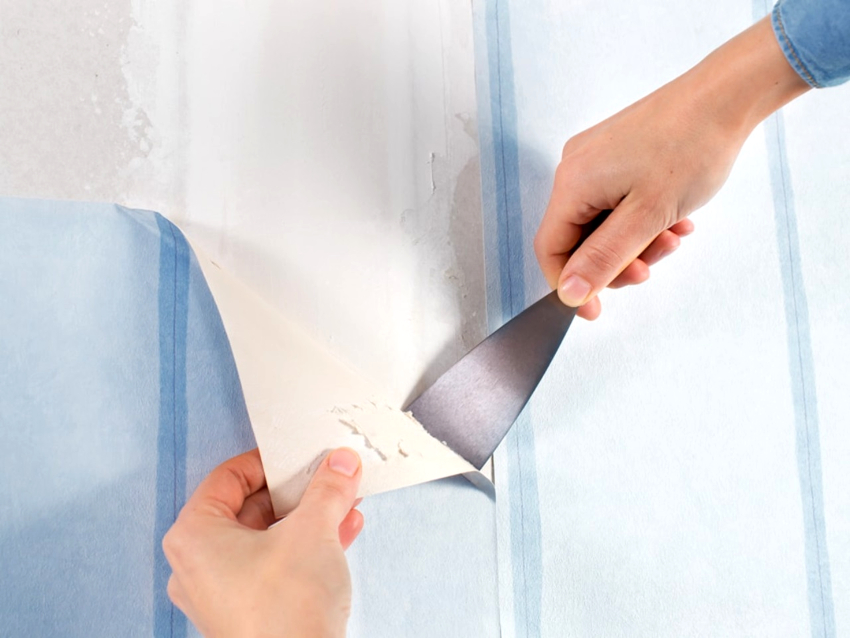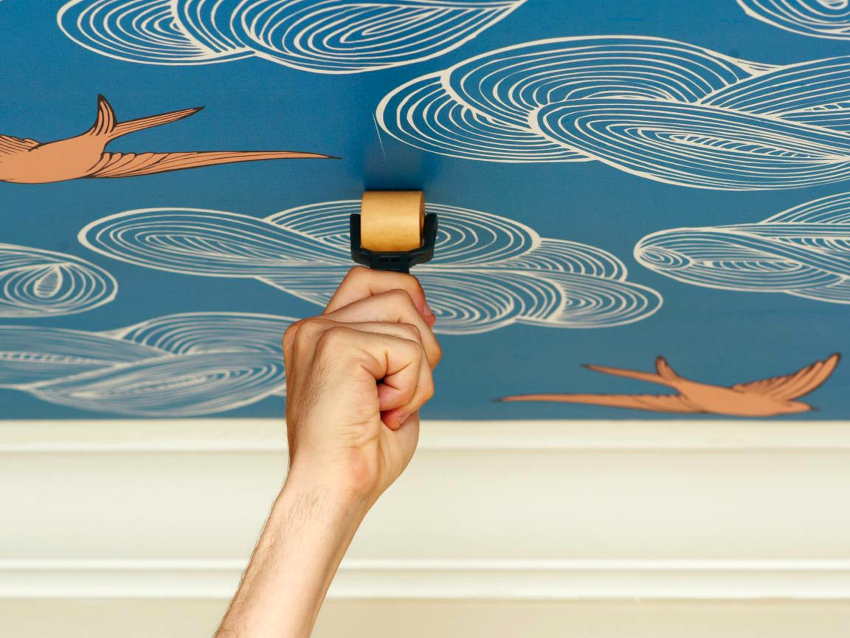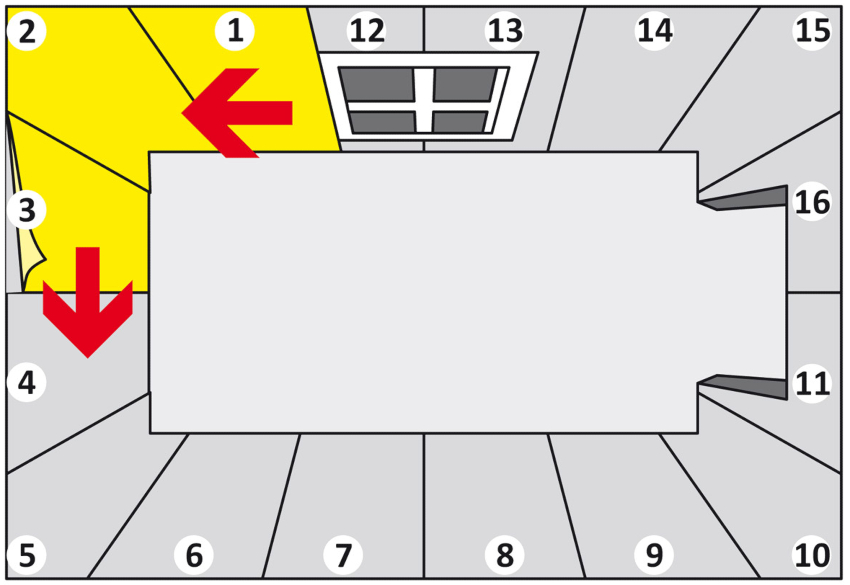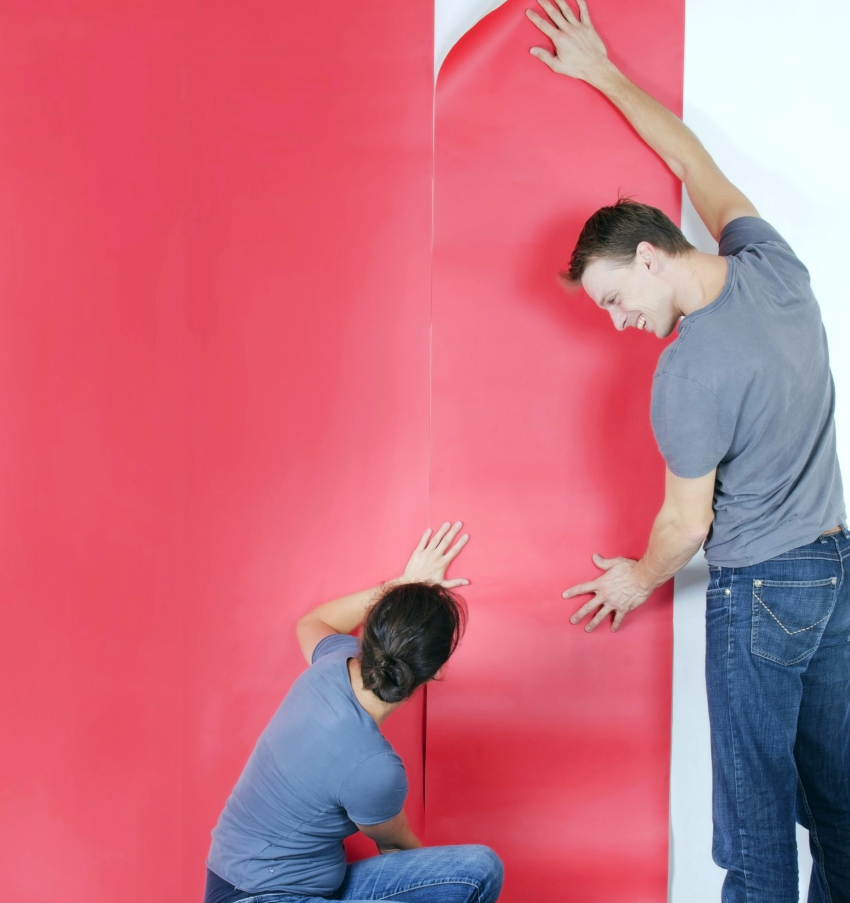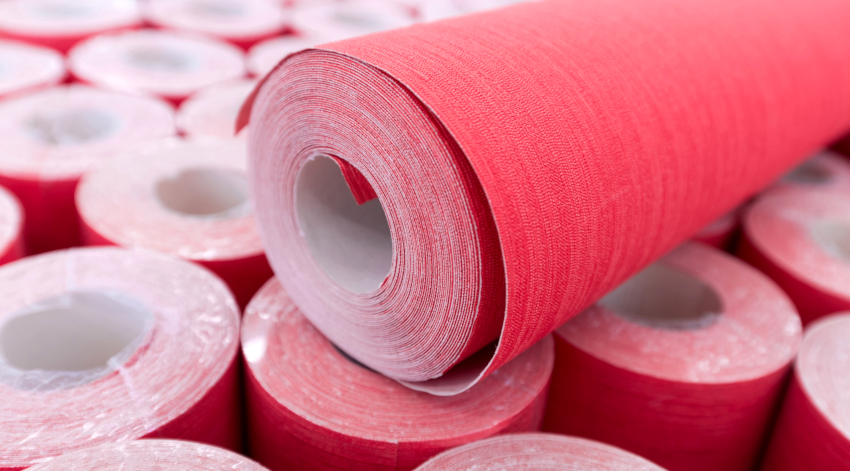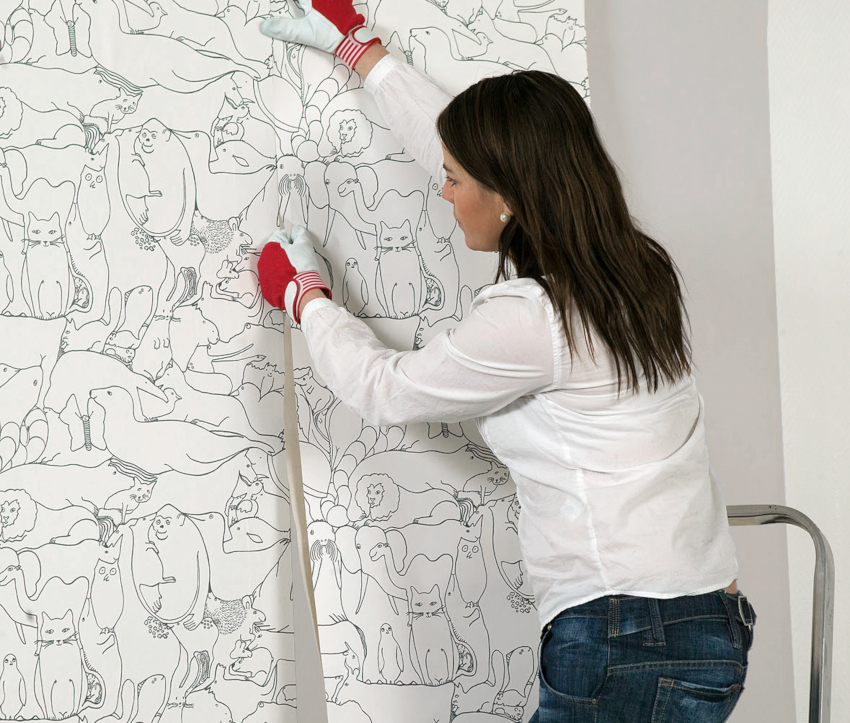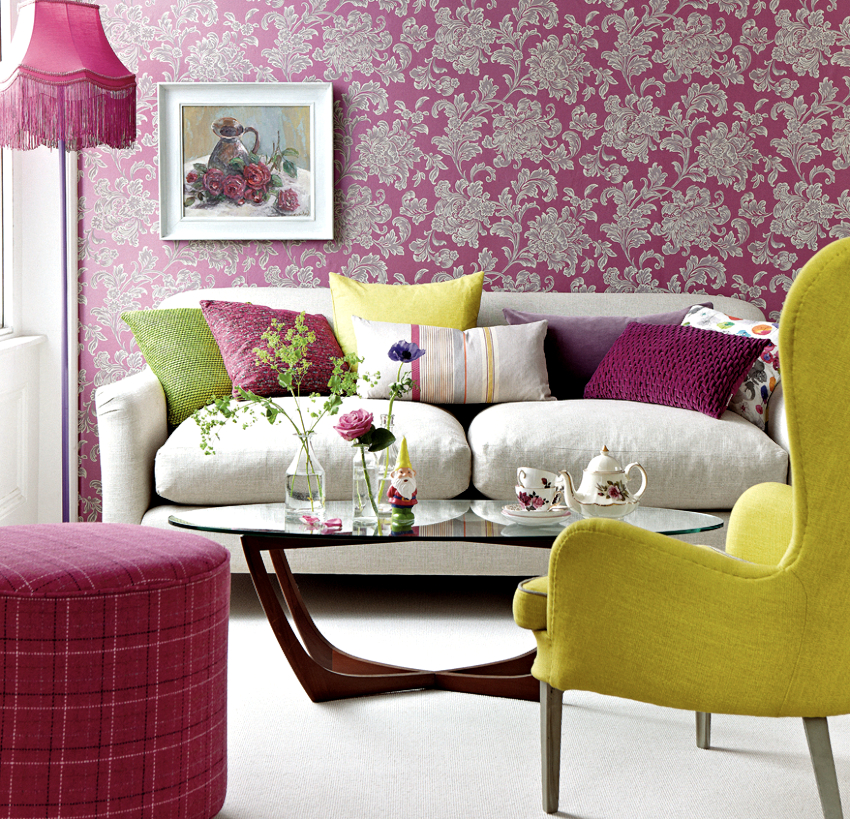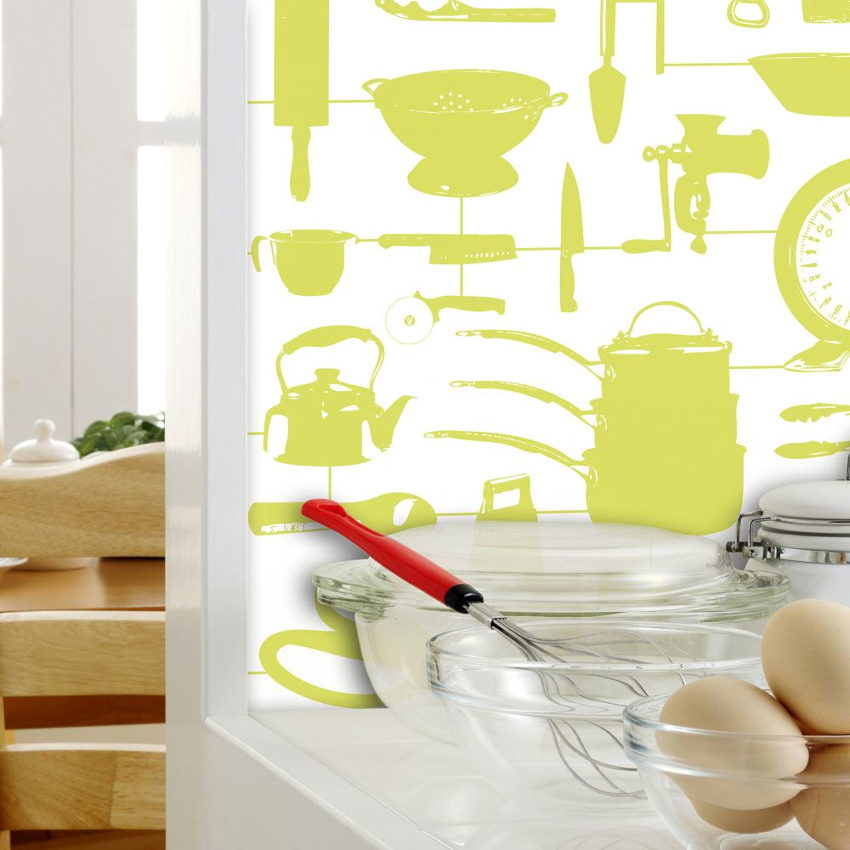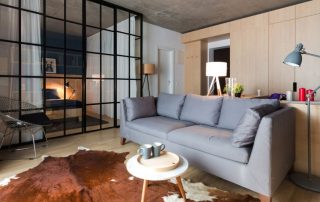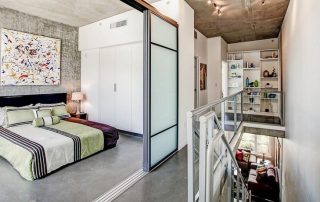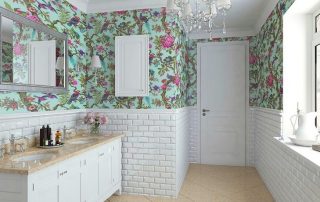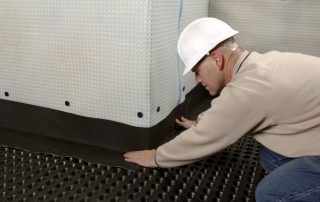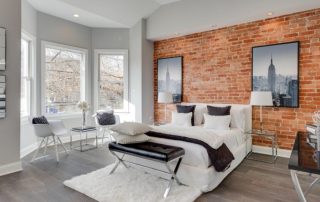Starting the final stage of the renovation - finishing the walls, you need to decide where to start gluing the wallpaper in the room, including in the hallway, in the kitchen. Each of these rooms has its own characteristics, which are manifested in lighting, the presence of corners, openings, niches or recesses. An important role is played by the layout of the apartment, as well as the type of wallpaper. The process of gluing non-woven, vinyl or paper canvases has its own requirements. All the nuances will be discussed in this article.
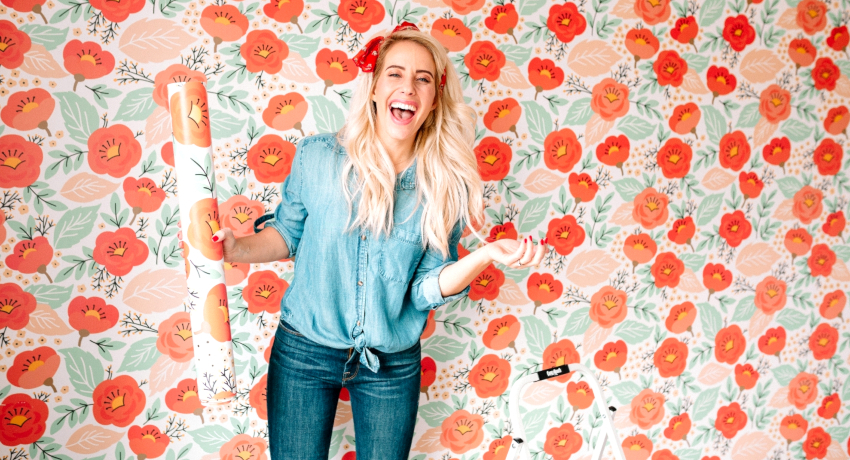
If you decide to glue the wallpaper yourself, you need to clearly know the sequence of actions to be performed.
Content
- 1 Wallpapering in the room: preparatory work
- 2 Where to start gluing wallpaper in the room on the ceiling
- 3 Where do you need to start gluing wallpaper in the room on the walls
- 4 What wallpaper to choose: density, texture, material color
- 5 Where to start gluing wallpaper in a children's room, bedroom or hall
- 6 Where to start gluing wallpaper in the kitchen, taking into account the specifics of the room
- 7 Features of using wallpaper in room design: recommendations of designers
Wallpapering in the room: preparatory work
If a decision is made to independently carry out repair work in a house or apartment, even if it is just a cosmetic repair, it is necessary to clearly determine the sequence of actions performed. First of all, you need to properly prepare the room. The preparation stage includes:
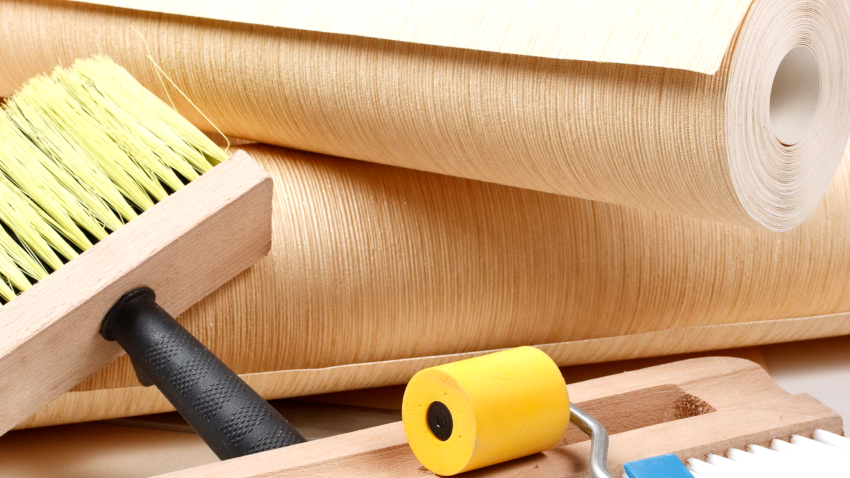
The preparation stage includes: purchasing wallpaper, selecting tools, covering floors, cleaning walls
- purchase of materials (wallpaper, glue, primer, edging, tools);
- selection of the necessary tools (scissors, tape measure, construction knife, brushes, roller);
- covering floors with protective material;
- preparation of walls and communications.
You should take care of the purchase of materials in advance. It is necessary not only to calculate the amount of decorative trim and glue mixture, but also to take care of how to apply glue to the walls when gluing wallpaper. It is most convenient to cover the floor with plastic wrap, simple newspapers are also suitable. For safety reasons, it is better to turn off the electricity, and for convenience, you can remove the lamps and outer boxes from the outlets. The room should be as spacious as possible, so it is advisable to take out the furniture or move it in the center and cover it with a film.
The surfaces to be glued require special careful preparation. Walls and ceilings must be cleaned of old coatings. Putty, leveling and priming of surfaces should be carried out. Before starting work, the room must be thoroughly ventilated, and then the windows and doors must be tightly closed to prevent drafts.
It is necessary to allocate a special place on the floor for marking and cutting the canvases, as well as for greasing them with glue. The features of gluing wallpaper of various types and in different rooms will be discussed in this article.
Where to start gluing wallpaper in the room on the ceiling
First of all, you need to decide where exactly the wallpaper is planned to be glued. If such finishing will be done throughout the room, including the ceiling, then you need to start with it. In this case, two methods of wallpapering are used (the photos show the sequence of works):
- from the wall;
- from the center of the ceiling.
The first method is considered simpler, but it is effective in the case when the wallpaper is without a pattern. These canvases are most often used to cover ceilings.
Useful advice! Before starting gluing, it is recommended to watch a special video on how to glue the wallpaper correctly, where to start work and how to dock the picture on the ceiling.
If wallpapering involves the need to observe patterns, then it is recommended to start working from the center to the sides - in this case, an equal number of whole strips will be consumed. After pasting from the center of the ceiling, the pattern will be located symmetrically, which will ensure its correct visual perception, since the outer strips will be of the same width, which will create a natural and harmonious look.
In the case of gluing from the center, it is necessary to mark the entire ceiling. To find the center point, it is enough to break the ceiling with a thread along the diagonals. The intersection of the threads clearly indicates the center. From this point it is necessary to mark a distance equal to half the width of the strip. Usually it is 26.5 cm - half of a standard stripe measuring 53 cm. Between the markings the first stripe will lie, and from it the rest of the pattern will "dance".
If the wallpaper is glued from the wall, then you need to draw a strip 50 cm wide, which should be clearly perpendicular to the window. The first sheet is glued at this mark, and the remainder at the wall is removed with a construction knife.
Where do you need to start gluing wallpaper in the room on the walls
When decorating walls with wallpaper, there are several options as to where to start gluing. The specific situation will tell you how to do this correctly. Be sure to consider the type of wallpaper used. Modern coatings, as a rule, are glued end-to-end in one of the following ways:
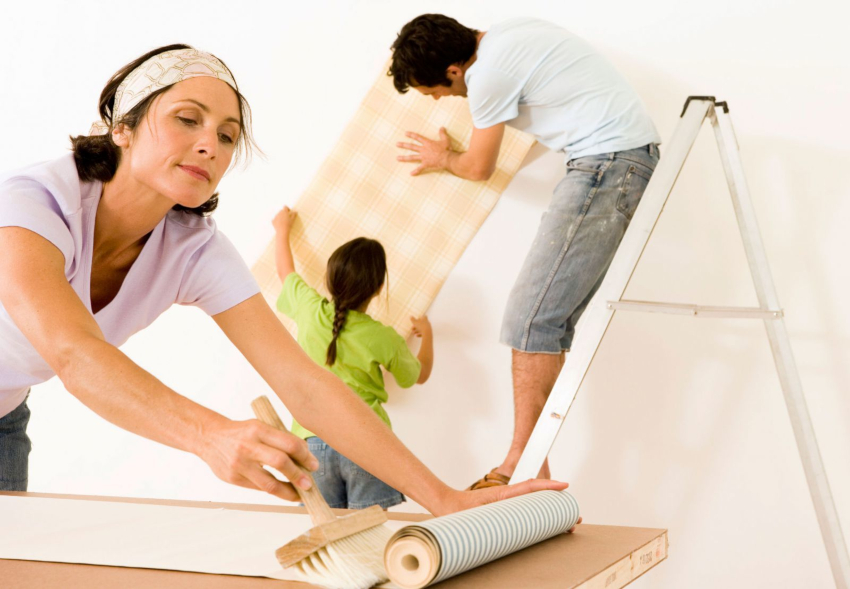
There are several options for pasting walls with wallpaper: from the middle of the wall, window, door, corner
- from the middle of the wall;
- from the window;
- from the door;
- from the corner.
Before starting work, make marks perpendicular to the floor, which are applied using a level or plumb line. There is another gluing method - diagonally. To do this, using a stretched thread, draw a line from the upper corner to the diagonally opposite one. Wallpaper is glued obliquely, guided by the outlined line. It is better not to use this method for novice craftsmen, since only experienced builders can do it.
In cases where wallpaper with a pattern is purchased, difficulties may arise in all variants of perpendicular pasting. You need to choose the most inconspicuous place, for example, above a window or a door - this is where to start gluing wallpaper, if there is a difficulty in joining patterns.
The technique of gluing wallpaper from the window is quite simple. It is necessary to measure the height of the room, add 10 cm to the resulting value for allowances for each strip. Next, the canvases are cut (with a comparison of the picture). The first strip is glued according to the perpendicular reference point. Subsequent canvases are glued sequentially, usually counterclockwise. The owners themselves decide where to start gluing the wallpaper in the room. Video tutorials, which are many on the Internet, will help you do it right.
How and where to start gluing wallpaper
It is recommended to glue combined wallpaper from the middle of the wall. The same method should be used in the case of making a wall panel from wallpaper, when it is necessary to maintain a clear symmetry in the drawing. This type of pasting will be discussed in detail later in the article.
Useful advice! It is better to glue the wallpaper over the sockets, from which the covers are first removed. Cut holes to the required size after the glue under the wallpaper has dried. It is also recommended to cut off excess parts of the wallpaper near the slopes, above the window and in other difficult places after the glue has dried.
The approach to the door must be symmetrical, so the strip should be cut vertically in half to the height of the doorway and glued on both sides. Then the wallpaper is fitted on top of the door.
If, when discussing the question of where to start gluing the wallpaper, it was decided to start working from the corner, then it is important to take into account a number of nuances. Firstly, perfectly flat corners are very rare. You can check evenness using a plumb line or level. Along the perpendicular in the corner, it is necessary to draw a straight line and it is from this line to start finishing the wall.
Secondly, experts do not recommend gluing a whole strip in the corner, since after drying, distortions or folds may form on the canvas, which will further entail inconsistencies in the drawing. In order for the wallpaper in the corner to lay down correctly, you must adhere to the following recommendations regarding their finishing:
- It is necessary to choose the most inconspicuous corner in the room, where you need to start gluing the wallpaper.
- The corners should be carefully smeared, since it is in this place that wallpaper most often peels off.
- The corners are a favorable place for the development of mold, therefore, before proceeding with pasting the walls, they need to be treated with special agents - fungicides.
What wallpaper to choose: density, texture, material color
To determine the choice of wallpaper for a particular room, it is necessary to take into account a number of significant factors, among which the following can be distinguished:
- the purpose of the premises;
- the condition of the wall or ceiling;
- room humidity;
- room area.
Based on the listed requirements, it is important to note that in dry rooms with flat walls, it is permissible to use any type of wallpaper. Only after the desired option has been selected, you can decide where it is best to start gluing the wallpaper. In rooms with high humidity and high traffic, it is better to use vinyl products.
In the modern construction market, there are different types of wallpapers, and each of them has its own characteristics:
- Paper, which, in turn, are divided into duplex and simplex. They perfectly fit even on the most difficult and hard-to-reach surfaces, so they can be combined with other types of wallpaper.
- Non-woven wallpapers have gained popularity due to their texture, reliefs with a dense structure, as they can perfectly hide irregularities on the surface. They have a different outer coating.
- Vinyl wallpapers are dense and very durable products, usually on a non-woven base. They are glued to walls, which are subject to all kinds of damage and dirt.
- Fabric or textile fabrics are among the most expensive type of wallpaper. They are perfect for a bedroom or living room, and will also help to mask minor mechanical damage on the wall.
- Liquid wallpaper in its structure and method of application is more like decorative plaster. They can be used in any room.
Wallpaper room design: rules for choosing products for different rooms and their combination
When choosing wallpaper for a room, it is necessary not only to be guided by the price and appearance, but also to take into account their physical characteristics.
Useful advice! The non-woven finish will not shrink after drying, and will also perfectly hide small irregularities. Another plus of non-woven wallpaper is the ease of gluing, since according to the technology, the glue is applied only to the wall.
The walls of a bedroom or nursery must "breathe", so paper wallpapers are ideal. Their main disadvantage is their short service life. Textile wallpaper can be an alternative to paper covering, but they are much more expensive.
Related article:
How to glue paper-backed vinyl wallpaper: useful tips for wall decoration
Features of paper and non-woven backing. The choice of glue. Aligning the walls. General advice.
A good option for the living room is silk screen printing. Its shiny surface will add respectability to the room. The color must be chosen in accordance with the furniture; large patterns and bright colors are inappropriate here. It is better to stop the choice on calm shades.
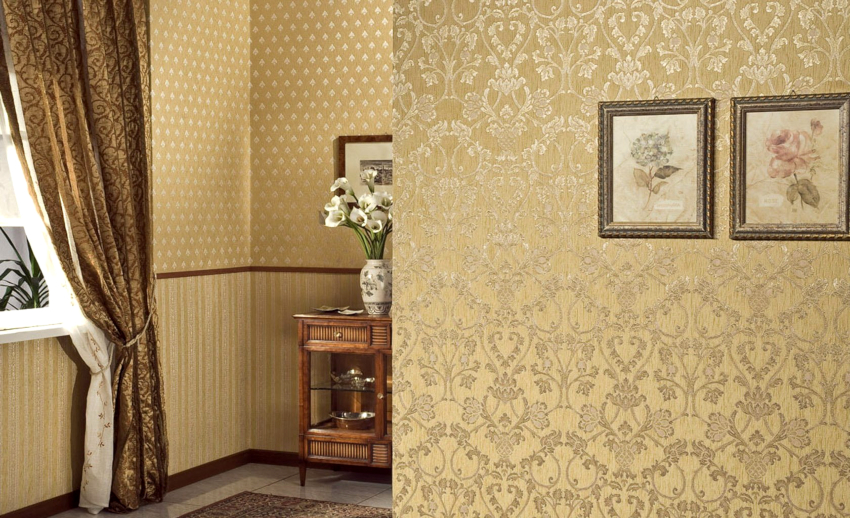
A good option for the living room is silk-screen printing, its shiny surface will give the room respectability
Vinyl wallpapers on a non-woven base have increased strength and, as a rule, have a water-repellent effect, so they are resistant to mechanical damage and all kinds of dirt. They can be cleaned and washed, making them ideal for kitchens and corridors.
When creating modern interior design, different wallpapers are often used in the room. Combining different coatings, not only in color, but also in texture, will help create a unique decor on the walls. By using different wallpapers, you can divide the room into different zones. Also, vertical or horizontal demarcation using companion wallpaper is quite popular. The photos show the original version of their application in the form of inserts.
Combination of technology and design: gluing different types of wallpaper
Different types of wallpapers are glued in different ways. For example, it is better to overlap paper canvases and start working from the window. To visually imagine where to glue the wallpaper, you just need to stand with your back to the window. Wallpaper should first be glued on the right side (towards the doors), and then, by analogy, on the left. The light from the window will hide the overlaps, so they will be invisible when entering the room. In a room without windows, it is better to glue from the doors, if there are several doors, then from any of them.
If the selected version of the wallpaper is non-woven or non-woven, then they must be glued end-to-end. Where is the best place to start gluing wallpaper in this case, it practically does not matter. You can start from a window, from a door, from a corner, or from the center of the longest wall. As an exception, the wallpaper can be positioned horizontally. This is a pretty bold decision that will help create an original interior.
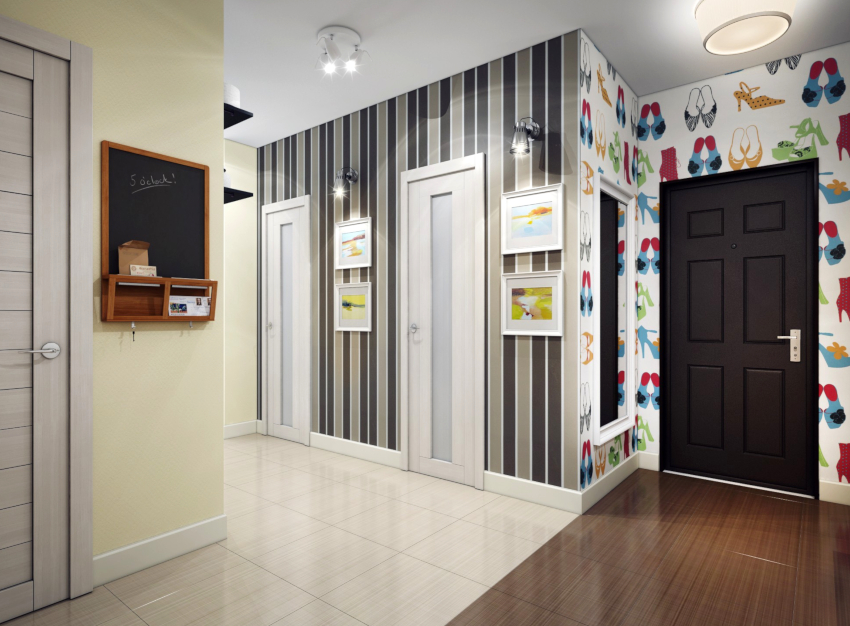
Non-woven wallpaper can be started from the window, from the door, from the corner or from the center of the longest wall
Another option is combined wallpaper, where the lower part is glued horizontally, and the upper part is glued vertically. Thus, a fancy pattern will come out, but in this case it is necessary to carefully choose the colors and textures of both types of products. This design is not only original, but also practical. For example, in the hallway, the lower part is more susceptible to dirt, and with this method of pasting, it can simply be replaced, leaving the top unchanged.
Where to start gluing wallpaper in a children's room, bedroom or hall
Features of gluing relate not only to the type of wallpaper, but also depend on where exactly they are glued.When deciding where to start gluing wallpaper in the hall, you need to pay attention to the presence of any large landmark in the room and start finishing work from it. It could be a corner, a window, or a door. It is important, based on preliminary measurements in different places, to determine the maximum and minimum wall heights. The gluing of the first strip must be carried out taking into account the average indicator.
Useful advice! The peculiarity of the wallpaper on a non-woven basis is the thickness of the canvas, therefore it is unacceptable to overlap them - only end-to-end.
If the room has a balcony door, and the distance from its door jamb is very small, then you can then choose the most distant corner. Since there are practically no ideally even corners, it is necessary to start gluing wallpaper after applying vertical marks on all walls.
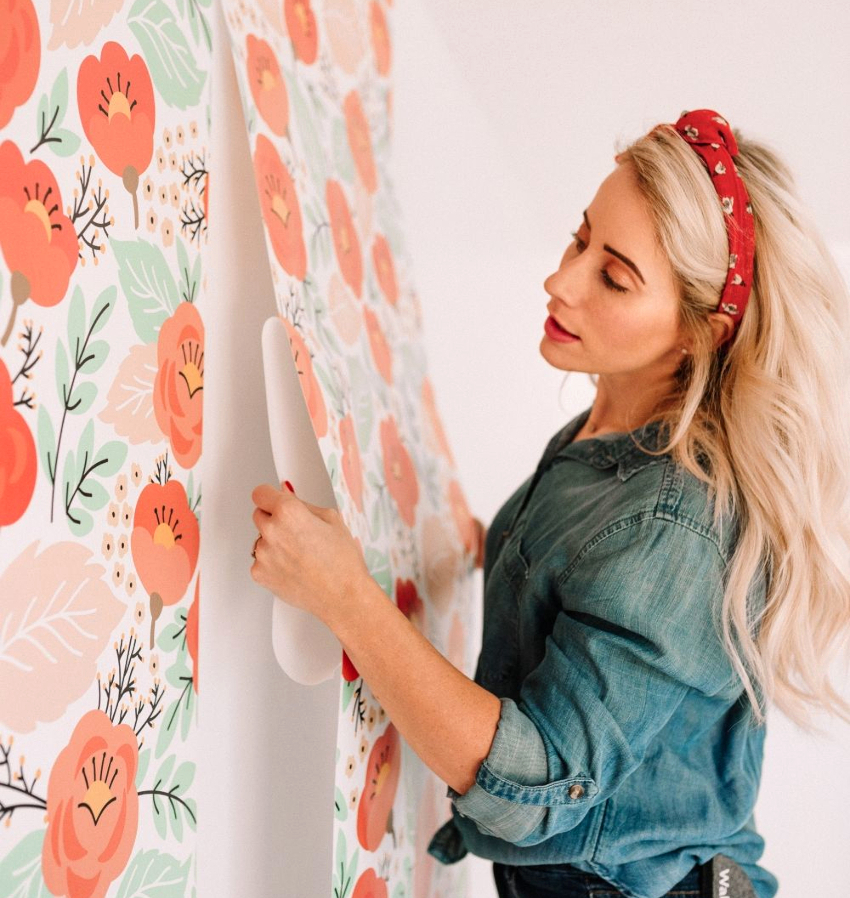
It should be noted that there is no single algorithm for decorating walls with wallpaper in different rooms.
It should be noted that there is no single algorithm for decorating walls with wallpaper in different rooms. Here, a special approach is important in each separate room. A particularly popular way among craftsmen is to start work from the front doors and glue the wallpaper in the room in two directions, or move clockwise and arrange the strips from left to right.
Thus, when gluing wallpaper in living rooms, it is necessary to follow the rules for joining. Then the joining points, even when direct light rays hit, will not be noticeable, and the wall surface will take on the appearance of a solid canvas.
Where to start gluing wallpaper in the hallway: tips and nuances
When deciding where to start gluing wallpaper in the hallway, it must be borne in mind that this room has a number of significant differences from other rooms. The main one is the absence of windows. In addition, there are more doors, openings and corners, both internal and external, than in any other room. The corridor is often decorated with arches. Therefore, here it is better to start gluing wallpaper from the farthest inner corner.
When the corners are even, the job will go quickly and easily. Otherwise (which is quite common), the order of work will be as follows:
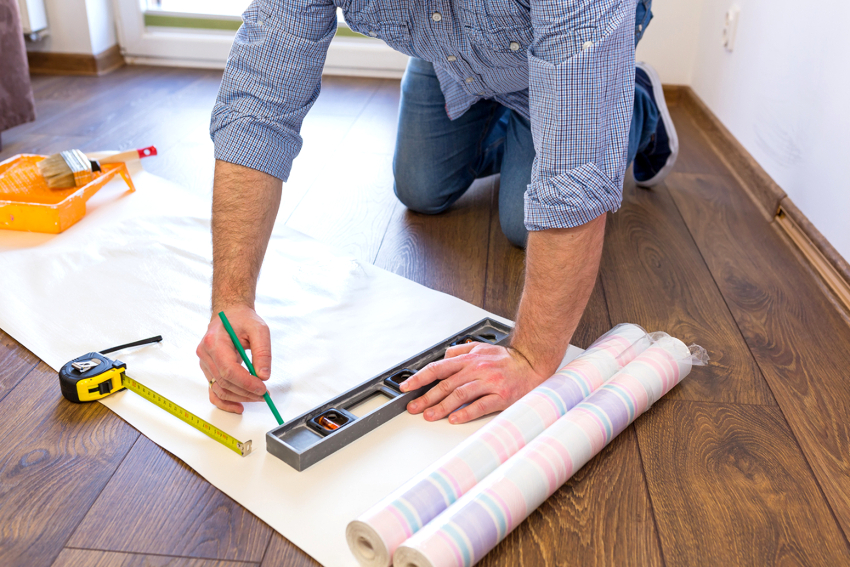
For gluing wallpaper in the corridor, it is advisable to use a special composition with increased adhesiveness
- On the wall opposite from the entrance doors, it is necessary to make a vertical mark using a building level or a plumb line at a distance of 10 cm from the nearest corner and stick the first strip.
- The next strip should be glued in such a way that its edge overlaps the adjacent wall, where a vertical line is also applied.
- If the room has complex geometry, then a vertical line must be applied for each strip.
For gluing wallpaper in the corridor, it is advisable to use a special composition with increased adhesiveness, and the walls should be carefully primed beforehand. No glue solution is applied to the wallpaper, they are applied dry to the wall so that their edges exactly coincide with the vertical mark. The edge is pressed and lightly ironed in the middle with a special spatula. Next, the surface is smoothed in the direction from the middle to the edges in a herringbone pattern.
Important! Applying an adhesive to walls and canvases at the same time can lead to complications in the work. Bubbles and wrinkles often appear on the surface, which do not always disappear even after complete drying. It is best to follow the manufacturer's instructions that come with the wallpaper.
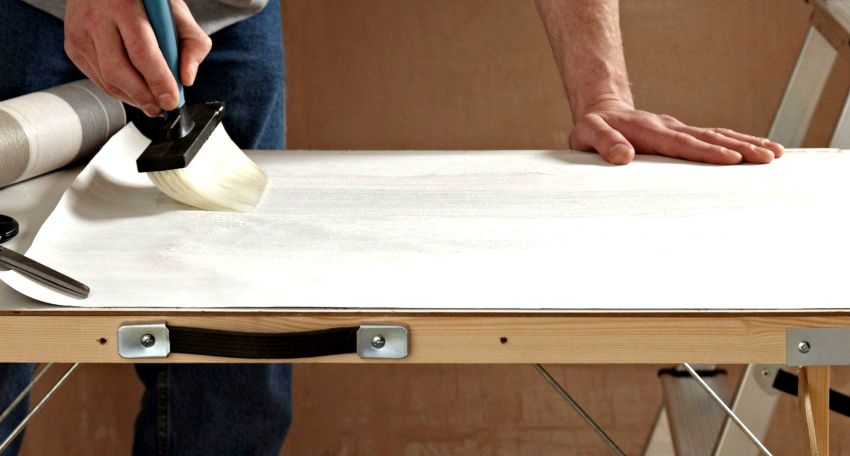
Applying an adhesive composition to walls and canvases simultaneously can lead to complications in work
Where to start gluing wallpaper in the kitchen, taking into account the specifics of the room
The peculiarities of the kitchen area complicate the wallpapering process a little. Here you should take into account the following nuances:
- the need to equip the kitchen with household appliances;
- allocation of space for a kitchen apron;
- taking into account the location of the door and window;
- division of the room into a work and dining area.
For the kitchen, the most suitable wallpaper options are vinyl or special canvases for painting. The ability to change the color of the wallpaper and the large width of the rolls are the main advantages of painting canvases. By using different types of products, you can successfully zone the kitchen.
The very procedure for carrying out the work practically does not differ from the process of gluing canvases in other rooms. Wallpaper must be glued to a good quality, as the walls in the kitchen are exposed to high temperatures and humidity.
The reliability of fixation will help to ensure certain gluing rules. To do this, you need to apply glue to the wrong side of the wallpaper, then wrap the edges in the middle and fold the strip again. For 10-15 minutes, the glue is well absorbed into the surface, after which you can proceed to gluing. The first strip is applied to the vertical mark and smoothed using a roller or rubber spatula.
Features of using wallpaper in room design: recommendations of designers
Designers advise to be very careful when choosing wallpaper, especially if they are supposed to be combined in the same room. When the wallpaper is selected with taste, the house will acquire the necessary comfort and beauty. You can achieve the desired result by following the recommendations:
- Harmony in the design of a room can be obtained by combining light wallpaper with a coating of the same shade, but with a bright pattern.
- You can create a bright accent in a room by decorating one wall with wallpaper that will stand out in color, but not texture.
- If the option of horizontal zoning is chosen, then it is imperative to use separate borders, moldings or a wide edging.
- In the children's room, you can use patchwork combination.
- Furniture upholstery, curtains and accessories must be selected taking into account the color and texture of the wallpaper.
- It is better to buy wallpaper, materials and decorative elements in one place.
- Pasting the corners with wallpaper in contrasting colors will help to visually smooth out irregularities.
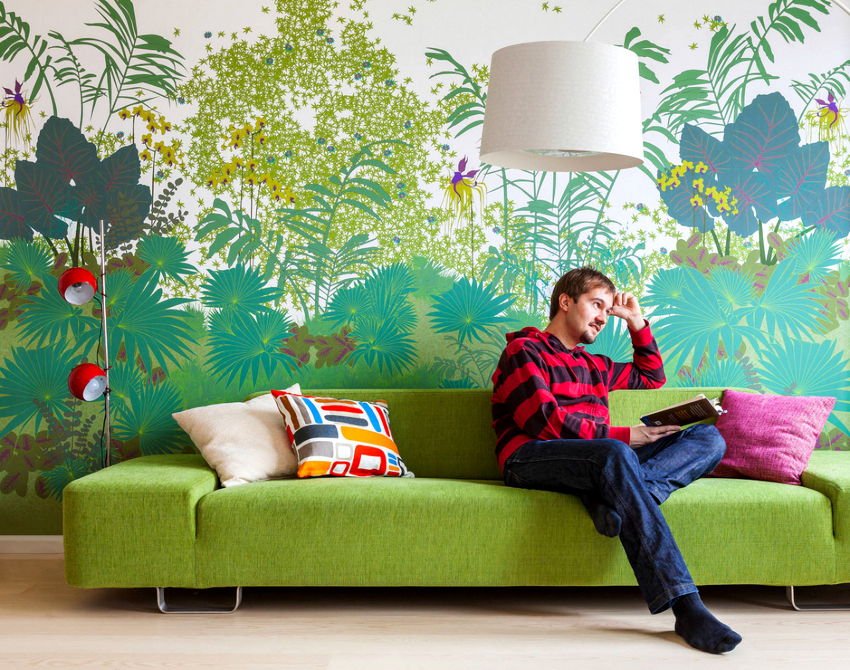
You can create a bright accent in a room by decorating one wall with wallpaper that will stand out in color
If a decision is made to glue the walls yourself, then you need to take into account the following nuances:
- repairs cannot be carried out in a hurry;
- calculations based on careful measurements will help reduce financial costs;
- correct organization of preparatory work will significantly reduce the repair time;
- do not neglect the instructions that come with wallpaper and glue mixtures;
- in the northern rooms it is better to choose wallpaper in light and warm colors;
- it is not recommended to air the room during the day after wallpapering.
Useful advice! In the design of walls, no more than 5 colors are allowed, and in small rooms you should not glue wallpaper with a large pattern.
The creation of the design of a house or apartment must be approached with great responsibility. Starting to decorate the walls in any room, you need to carry out preparatory work, choose wallpaper and decide where to start gluing them. Compliance with all the rules and instructions will help you avoid common mistakes and create comfort and coziness in your home with your own hands.
